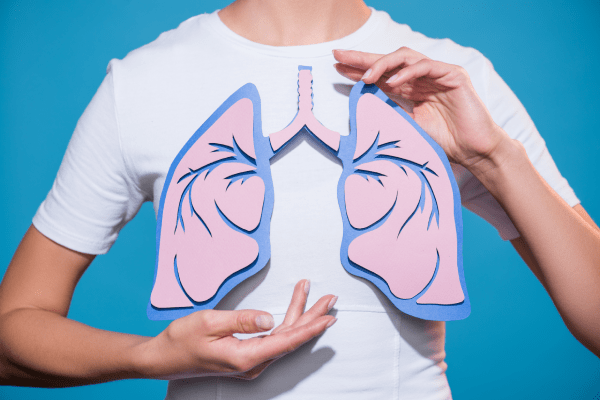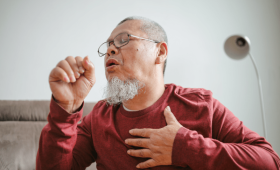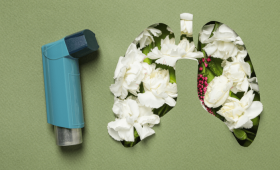Is COPD Completely Curable or a Chronic Disease that Needs to be Managed?
Unfortunately, COPD is not a completely curable disease; it is an inherently progressive, chronic condition. The damage that occurs in the lungs is permanent and irreversible. The disease is fundamentally caused by the loss of elasticity in the air sacs (alveoli) and the inflammation and narrowing of the airways due to exposure to harmful gases and particles.
Because of this permanent damage, treatment focuses on controlling symptoms, improving quality of life, and slowing the rate of disease progression, rather than curing the disease. An effective treatment plan initiated with early diagnosis helps the patient preserve lung function for as long as possible and prevent severe exacerbations. For this reason, viewing COPD as a lifelong journey that needs to be managed increases treatment adherence and improves long-term outcomes.
What Are the Most Effective Treatment Methods to Slow the Progression of COPD?
The most effective and critical step in slowing the progression of COPD is to quit smoking completely if you are a smoker. Cigarette smoke is the primary cause of the disease and a constant source of harm to the lungs. Quitting smoking stops this continuous damage, significantly slowing the disease’s progression. In addition, regular and correct use of medication is a cornerstone of COPD management. Inhaled bronchodilators help open up airways, reducing shortness of breath.
Furthermore, pulmonary rehabilitation programs help patients manage their sensation of breathlessness by increasing their exercise capacity. These programs include personalized exercises, nutritional counseling, and psychological support. Finally, avoiding environmental factors like air pollution and getting regular flu and pneumonia vaccines are also of vital importance for slowing the disease’s progression.
Why Are Inhalers So Important in the Treatment of COPD?
Inhalers (inhaled medications) are an indispensable part of COPD treatment because they deliver medication directly to the lungs, which is the main area affected by the disease. This method minimizes the absorption of the drug into the bloodstream, resulting in far fewer systemic side effects compared to oral medications. Inhalers quickly widen the narrowed airways, providing immediate relief from symptoms like shortness of breath and wheezing.
Direct delivery of the medication to the target tissue in the lungs allows for high efficacy even with lower doses. Regularly used long-acting inhalers help patients keep their daily symptoms under control, increase their physical activity capacity, and reduce the frequency of COPD exacerbations. Correct inhaler technique is a critical factor for the success of the treatment, which is why patients should receive training on how to use their inhalers properly.
How Do Different Types of Inhalers (Bronchodilators, Steroids) Work?
Inhalers used in COPD treatment are mainly divided into two groups and have different mechanisms of action. Bronchodilators, as the name suggests, relax the muscles surrounding the airways, widening the narrowed passages and facilitating airflow. Bronchodilators are divided into two types based on their duration of action: short-acting bronchodilators are used for immediate relief during attacks of breathlessness, while long-acting bronchodilators are taken regularly once or twice a day to maintain continuous symptom control.
Steroids (Corticosteroids), on the other hand, target chronic inflammation in the lungs. They help keep the airways more open by reducing swelling and mucus production. Steroids are often used in combination with bronchodilators, and are particularly effective in patients who experience frequent exacerbations or have more severe symptoms. The combined use of both types of medication provides a more comprehensive treatment by both widening the airways and controlling inflammation.
When is Oxygen Therapy Recommended to Relieve Shortness of Breath in COPD Patients?
Oxygen therapy is a treatment recommended for COPD patients when their blood oxygen levels are dangerously low (hypoxemia). This condition usually occurs in the advanced stages of the disease. A doctor evaluates the patient’s blood gas values or pulse oximeter measurements to determine the need for oxygen therapy.
Oxygen therapy helps relieve the sensation of shortness of breath, reduces fatigue, and increases the patient’s exercise tolerance by ensuring sufficient oxygen reaches vital organs. It has been scientifically proven that long-term oxygen therapy (at least 15 hours a day) prolongs life expectancy and helps prevent complications like heart failure in patients with advanced disease. The duration and dose of treatment are determined according to the patient’s needs. Some patients may only need oxygen while sleeping or exercising, while others may require continuous oxygen support throughout the day. Oxygen therapy must be started and monitored under a doctor’s supervision.
What Does a Pulmonary Rehabilitation Program for COPD Patients Involve?
Pulmonary rehabilitation is a comprehensive and personalized program aimed at improving the overall health and quality of life for COPD patients. The core components of the program include: Exercise Training: Aerobic (walking, cycling) and resistance exercises increase muscle strength, including the respiratory muscles, improve physical endurance, and enhance the ability to manage shortness of breath. Disease Education: Patients are educated on the nature of COPD, correct medication use, recognizing the signs of exacerbations, and breathing techniques.
This education empowers the patient to better manage their own condition. Nutritional Counseling: COPD patients are at risk of malnutrition due to high energy needs and difficulties with swallowing. Nutritionists create an appropriate diet plan to maintain ideal body weight and support the strength of respiratory muscles. Lastly, Psychological Support: Strategies for coping with anxiety and depression caused by COPD are provided through psychotherapy, cognitive-behavioral therapy (CBT), and support groups. This program helps patients cope more effectively with their symptoms and maintain their independence.

What is the Biggest Impact of Quitting Smoking on the Prognosis of COPD?
Quitting smoking is the single most impactful action that halts the progression of COPD and radically improves a patient’s prognosis. Cigarette smoke causes chronic inflammation and structural damage in the lungs, which leads to a permanent decline in lung function. Quitting smoking stops this ongoing process of damage and brings the annual rate of decline in lung function closer to the normal rate seen in healthy individuals.
This not only slows the disease’s progression but also contributes to a reduction in symptoms and an improvement in overall health. After quitting, patients may experience less coughing and phlegm production, breathe more easily, and participate in physical activities more readily. Quitting smoking also significantly reduces the risk of other smoking-related diseases like heart disease, cancer, and stroke. Therefore, the most crucial intervention for a COPD patient is support in quitting smoking entirely.
What Are the Main Causes of COPD Exacerbations (Attacks) and How Can They Be Prevented?
COPD exacerbations, or attacks, are a sudden and severe worsening of a patient’s typical symptoms (cough, phlegm, shortness of breath). These exacerbations are usually triggered by respiratory infections (influenza, pneumonia, common cold) or environmental factors like air pollution. Exacerbations may require hospitalization and can lead to permanent loss of lung function, making their prevention vital.
The most effective ways to prevent exacerbations are: First, get your flu and pneumonia vaccines regularly. These vaccines protect you from the most common infectious triggers. Second, avoid irritants like cigarette smoke, polluted air, chemical fumes, and dust. It’s important to avoid going outside on days with high air pollution and to maintain good indoor air quality. Finally, use the medications prescribed by your doctor regularly and correctly. This protects your lungs and reduces the risk of an exacerbation.
In What Situations Are Antibiotics Used During a COPD Exacerbation?
Antibiotics are used during a COPD exacerbation when a bacterial infection is suspected in the airways. Since most exacerbations are caused by viral infections, antibiotic use is not necessary for every exacerbation, and unnecessary use can lead to antibiotic resistance. When deciding on antibiotic use, doctors typically look for changes in the amount, color (yellow or green), and consistency of phlegm. In addition, symptoms like a high fever, increased cough severity, and general fatigue can also be signs of a bacterial infection.
If these symptoms are present, the doctor starts the patient on an appropriate course of antibiotics. The goal of the treatment is to control the bacterial infection, reduce the severity of the exacerbation, and stabilize the patient’s condition. It is very important for patients to avoid self-medicating with antibiotics and always follow a doctor’s advice.
How Common is Surgery as a Treatment Option for COPD and for What Conditions is It Suitable?
Surgery is a rare treatment option for COPD and is only suitable for certain, advanced-stage patients. The most common surgeries performed are lung volume reduction surgery (LVRS) and bullectomy. Lung volume reduction surgery is the surgical removal of a portion of the most damaged, non-functional lung tissue due to emphysema. This creates more space for the remaining healthy lung tissue to work more efficiently and allows the diaphragm to move better.
This operation is effective only in selected patients with concentrated damage in specific lung regions, sufficient respiratory muscle strength, and no history of active smoking. Bullectomy is the removal of large, non-functional air sacs (bullae) that have formed in the lung. These bullae can press on other healthy tissues, making breathing difficult. This surgery can significantly relieve symptoms for patients with suitable size and location of bullae. Both surgeries require the patient’s general health to be good enough to withstand the operation and carry risks.
Why Are Vaccines Against Respiratory Infections Like Flu and Pneumonia Vital for COPD Patients?
Vaccines against respiratory infections like the flu and pneumonia are vital for COPD patients because these infections are the most common cause of COPD exacerbations. For a COPD patient, a simple flu or pneumonia can worsen the existing inflammation and damage in the lungs, leading to a severe exacerbation and even hospitalization.
Such exacerbations can cause a permanent loss of lung function and severely reduce quality of life. Vaccines prepare the body’s immune system against infectious agents, ensuring that if exposure occurs, the illness either does not develop at all or is much milder. The flu vaccine should be administered annually, and the pneumonia vaccine at specific intervals. Vaccines are an integral part of a COPD patient’s self-protection strategy and help protect both individual and public health.
What Role Does Nutrition Play in COPD Management?
Proper nutrition plays a critical role in COPD management. COPD can increase a patient’s energy needs because they expend more effort to breathe than a healthy person. Malnutrition and weight loss can lead to a decrease in muscle mass, including the respiratory muscles, which in turn worsens breathlessness. Therefore, it’s very important for patients to get enough protein, calories, vitamins, and minerals to maintain muscle strength and their ideal body weight.
A healthy diet also strengthens the immune system, reducing the risk of infection. Furthermore, some nutrients (e.g., antioxidants) may help reduce inflammation in the lungs. Adequate fluid intake also thins phlegm, making it easier to cough up. Patients should eat small, frequent meals to help prevent shortness of breath during and after eating. Since every COPD patient’s nutritional needs can vary, it is best to seek professional help from a dietitian.
How Can the Psychological Effects of COPD, Such as Anxiety and Depression, Be Managed?
Anxiety and depression caused by COPD are common psychological effects that can be as challenging as the disease itself. The sensation of breathlessness can lead to panic and anxiety attacks. The chronic nature of the disease and physical limitations can also cause social isolation and depression. These conditions further reduce a patient’s quality of life and can negatively impact treatment adherence. There are several methods for managing these psychological effects.
First, psychotherapy or cognitive-behavioral therapy (CBT) is very effective in coping with anxiety and changing negative thought patterns. Joining support groups reduces feelings of loneliness and increases motivation by allowing patients to connect with others who have similar experiences. Regular physical activity and breathing exercises also play a significant role in reducing anxiety and improving mood. In necessary cases, anxiolytic or antidepressant medications can be used with a doctor’s recommendation. Patients should be encouraged to openly discuss these psychological problems and seek professional support.

How Do Treatments Administered in the Early Stages of the Disease Affect Long-Term Outcomes?
Treatments initiated in the early stages of COPD have an extremely positive effect on the disease’s long-term outcomes. Early intervention slows the rate of decline in lung function and limits the extent of progressive damage. Quitting smoking during this period is the greatest opportunity to minimize the loss of lung function in later years.
The regular use of inhaled bronchodilators keeps the airways open, controls symptoms, and allows patients to stay more active. Fewer symptoms mean fewer exacerbations, which in turn prevents sudden and permanent loss of lung function. Pulmonary rehabilitation programs started in the early stages help patients learn to better cope with breathlessness and increase their physical activity capacity, helping them maintain their quality of life in the long run. In short, early treatment slows the devastating effects of the disease and allows the patient to live a more independent, active, and high-quality life.
Is a Lung Transplant a Treatment Option for COPD and What Criteria are Required?
A lung transplant is a treatment option for COPD but is generally considered a last resort for patients with advanced disease where all other treatment options have failed, quality of life is very low, and life expectancy is short. Candidates for a lung transplant must meet very strict criteria. These criteria include advanced respiratory failure and the absence of any other serious disease in other organ systems (heart, kidneys, etc.) that would risk the transplant. The patient must also be mentally and physically capable of adhering to the intensive post-transplant medical follow-up and treatment regimen (such as lifelong immunosuppressant drugs). Furthermore, patients with an active smoking history are not considered suitable candidates for a transplant as it increases the risk of post-operative complications. A lung transplant, when successful, can significantly improve a patient’s quality of life, but it is also a major surgical operation with serious risks and complications.
What Are the Newly Developed COPD Medications and Treatment Approaches?
Research is continuously being conducted on new medications and treatment approaches for COPD. One of the new drugs developed is a triple combination inhaler that contains multiple active ingredients in a single inhaler, both widening the airways and reducing inflammation. These medications simplify patients’ medication regimens, increasing treatment adherence and improving symptom control. Furthermore, bronchoscopic (non-surgical) methods developed as an alternative to lung volume reduction surgery are becoming increasingly common.
In these methods, small valves or coils are placed endoscopically into the lungs to reduce the volume of the damaged areas. This allows patients to achieve similar benefits without the need for surgery. Stem cell therapies are also being investigated at an experimental level but are not currently a standard treatment method. These new approaches have the potential to offer more effective and less invasive treatment options for COPD patients.
How Effective is Protection from Air Pollution and Allergens in Relieving COPD Symptoms?
Protecting oneself from air pollution and allergens is highly effective in relieving COPD symptoms and preventing exacerbations. Air pollution contains harmful particles like cigarette smoke that irritate the already sensitive airways of COPD patients, increasing inflammation. Allergens (pollen, dust mites, pet dander) can also trigger symptoms in some patients.
Avoiding these triggers reduces both daily symptoms (coughing, wheezing, shortness of breath) and the risk of exacerbations. Therefore, it can be beneficial to avoid going outside on days with poor air quality (when air pollution warnings are issued), wear a mask if you have to be outdoors, and use an air purifier indoors. For patients with allergies, reducing exposure to allergens (such as frequently washing bed linens or reducing carpet use at home) helps achieve better symptom control.
What Technological Devices Can Be Used for At-Home Monitoring of COPD?
There are many technological devices that can be used for at-home monitoring of COPD. The most common of these is the pulse oximeter. This small device is placed on a fingertip to measure blood oxygen saturation (SpO2) and pulse rate. Patients can regularly check their oxygen levels to detect a potential drop or issue early and notify their doctor. In addition, smart inhaler devices are becoming increasingly common.
These devices track the frequency and technique of inhaler use, providing feedback on the effectiveness of the treatment and can alert patients who forget to take their medication. Telemedicine platforms and mobile applications are also used for COPD monitoring. These applications allow patients to record their symptoms, activity levels, and measured data (like pulse oximeter values) and share this data with their doctor, facilitating remote monitoring. These technological tools empower patients to better understand and manage their own condition.
What Are the Effects of Physical Activity on the Quality of Life of COPD Patients?
Regular physical activity significantly improves the quality of life for COPD patients. As the disease progresses, physical activity levels decrease due to shortness of breath, which leads to muscle weakening and a decline in fitness. This creates a vicious cycle that further worsens breathlessness. Regular exercise breaks this cycle.
Light-to-moderate activities like walking, cycling, or swimming strengthen body muscles, including the respiratory muscles, and allow for more efficient use of oxygen. This helps patients feel less tired and experience less shortness of breath when performing daily tasks (shopping, housework). Exercise also reduces symptoms of anxiety and depression, improves sleep quality, and increases the patient’s overall sense of well-being. A doctor should always be consulted before starting physical activity, and a personalized exercise plan should be created.
What Does Palliative Care Mean in the Final Stages of COPD?
Palliative care administered in the final stages of COPD is a specialized type of care that focuses on meeting the physical, emotional, and spiritual needs of the patient and their family, rather than treating the disease itself. Palliative care can be applied at any stage of the disease, not just near the end of life.
However, it becomes more important in the final stages when symptoms like shortness of breath, pain, and fatigue become more severe. The main goal of palliative care is to maximize the patient’s quality of life and ensure their comfort. This care includes symptom management (medications for shortness of breath, pain relievers), psychological and spiritual support, helping the patient and family make difficult decisions, and planning for end-of-life care. This approach aims to alleviate the psychological and social burden of COPD in addition to its physical burden.



